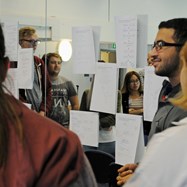University application figures 2012
30 January 2012
Commenting on the release of UCAS data on university applications for 2012 entry, Russell Group Director General Dr Wendy Piatt, said:
“Demand for higher education is not only strong - it’s actually rising over the long-term. This year 540,073 prospective students have applied, which is 16 per cent more than the 464,167 who applied just three years ago in 2009. More than half a million potential students have rightly recognised the benefits of going to university. Prospective students know a good degree remains a smart investment.
“It’s not surprising the number of applications is lower than last year, but there are a number of reasons for that. Demographic changes mean there are fewer 18-year-olds in 2012 than in 2011 and we also know there was a peak in applications last year as fewer people chose to take gap years.
“So overall it is encouraging to see that applications from 18-year-olds, who are the largest group of potential university entrants, are down by just 2.6 per cent compared to last year.
“There is more of a drop in applications from mature students and we will be monitoring any enduring behavioural changes in this group, who tend to have more flexibility over when they apply for higher education.
“Despite all the hype, fee reforms are unlikely to cause a long-term decline in applications. In the past a fall in applications in the first year of higher fees has been followed by increases in subsequent years.
“Money worries shouldn’t stop anyone from applying: there are no up-front fees, repayments are only made when they’re affordable and there is generous help with living costs. If you’re good enough to get in, you can afford to go. About one in three Russell Group students receive a bursary or scholarship that never has to be repaid, and our universities are spending unprecedented sums on financial support. Every student with the talent, potential and ability to succeed at a Russell Group university should apply.
“There has been much misinformation about the effect of fees on access. Since the introduction of fees, Russell Group universities have attracted more students than ever from non-traditional backgrounds. We are concerned that the overheated debates around university finance have distorted the facts among many young people and their families. Going to a good university is a sound investment for the vast majority. Most graduates earn a considerable salary premium over those with two A-levels, and Russell Group graduates typically receive a 10 per cent salary top-up over others.”
Notes to editors
- Total applicants through UCAS by 15 January deadline by year:
|
2008 |
2009 |
2010 |
2011 |
2012 |
|
430,489 |
464,167 |
570,556 |
583,546 |
540,073 |
- There was a 1.4 per cent decline in 18-year olds from 2011 to 2012 , Table A3-1: Principal projection - UK population single year of age
- All 18 year olds are down 2.6 per cent, UK 18 year olds are down 3.6 per cent between 2011 and 2012.
- With the introduction of English ‘top-up fees’ in 2006, applications decreased by 4.5 per cent but were followed by a 7.1 per cent increase in 2007 and a 10.1 per cent increase in 2009. (Source: UUK, variable tuition fees in England: assessing their impact on students and higher education institutions)
- By 2015-16 Russell Group universities in England plan to spend £153.7million of their additional fee income on financial support for students. This represents an average per institution of £9.6million with some of our universities spending as much as £17million. Overall, this amounts to over £5.9million more per institution than the sector average of £3.7million. This investment will be targeted so that those in most need of financial support receive the help they need.
- In 2015-16 the £28.8million which Russell Group Universities will spend on outreach measures will be used to support numerous summer schools, open days, special entry routes and access programmes to give students from lower socio-economic groups the best possible chance of winning a place. See http://www.russellgroup.ac.uk/widening-participation/ for more details of outreach activities and initiatives undertaken by Russell Group universities.
- The proportion of students from state schools at Russell Group universities has increased from 68.3 per cent in 1997, to 74.5 per cent in the most recent year. This growth in state school pupils is faster than for UK universities as a whole, where the proportion grew from 81.8 per cent to 88.5 per cent. (Source: HESA Performance Indicators, Table 1a: Percentage of young first degree students entering higher education.)
- Chevalier, A. and Conlon, G. Does it pay to go to a prestigious university? Centre for the Economics of Education, LSE (March 2003)
-
Hamir Patel
hamir.patel@russellgroup.ac.uk
020 3816 1316
-
Hollie Chandler
Hollie.Chandler@russellgroup.ac.uk
020 3816 1307
 X
X


